![Earthrise as seen from Apollo 8, December 24, 1968. By NASA / Bill Anders [Public domain], via Wikimedia Commons](https://www.peterharrington.co.uk/blog/wp-content/uploads/2016/11/NASA-Apollo8-Dec24-Earthrise-768x768-e1487091432131.jpg)
Earthrise as seen from Apollo 8, December 24, 1968. By NASA / Bill Anders [Public domain], via Wikimedia Commons
Science fiction has progressed beyond the space operas which inform the stereotypes of the genre, and now deals as often with the forces which might alter life as we know it from within our own atmosphere, as those which might be found in galaxies far far away. However, during the period between the 1950s and 1970s, when the popular imagination was captured by the international space race, the stories causing sci-fi to soar into the stratosphere were fact rather than fiction. This blog looks at a few items from the collection of Dr Homer E. Newell, a former NASA administrator, which illustrate the endeavours of man to understand the universe in the golden age of space exploration. A companion piece will bring together some works of sci-fi which emerged from the same period of human history. Together, these demonstrate the ability of the human race to pursue knowledge of the origins of our universe and speculate on its future.
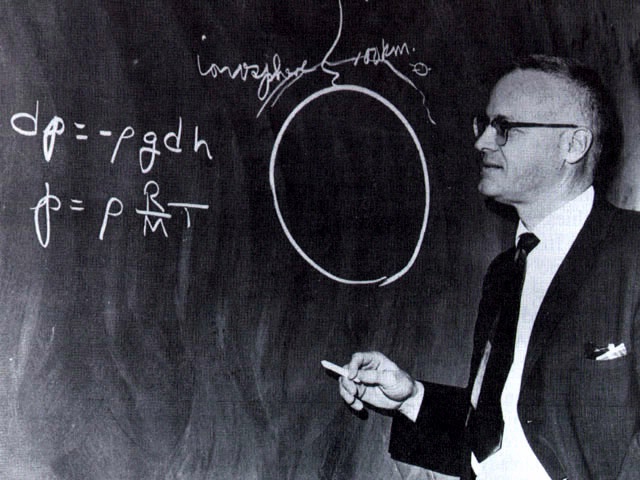
Dr Homer E. Newell Jr
From the library of Dr Homer E. Newell Jr
The following three items were recently acquired from the collection of Dr Homer E. Newell Jr. Newell was an American scientist and mathematician who was instrumental in the creation of NASA, having long been an advocate for the creation of a civilian space agency. On the establishment of NASA in 1958, Newell was given credit by his peers for being a strong driving force in negotiations. He joined NASA in its inaugural year and held several successive positions there, eventually rising to the post of associate administrator, third in command at the agency. During his time with NASA, he was instrumental in the development of plans for lunar exploration.
Newell was the recipient of many honours for his work, including NASA’s Distinguished Service Award and in 1965, the President’s Award for Distinguished Federal Service. He kept an extensive collection of books on space science and the surrounding fields, and authored eight works of his own. This is the first time that books from Newell’s collection have been available on the market.
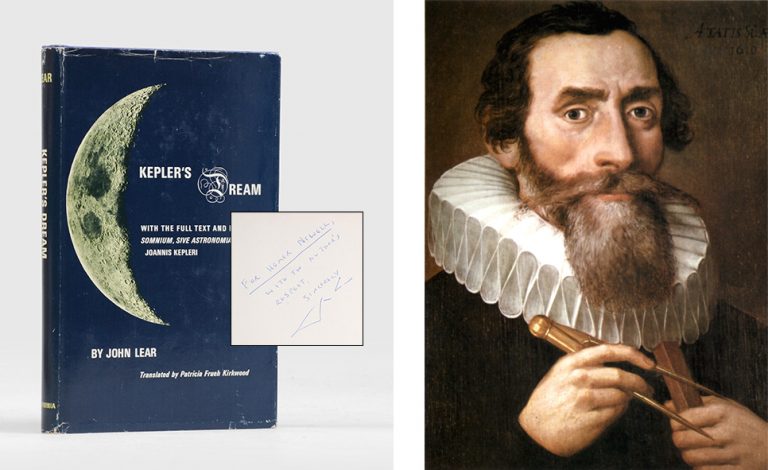
Kepler’s Dream by John Lear (Item sold)
This presentation copy is inscribed ‘For Homer Newell, with the author’s respect, sincerely John Lear’. This book is the first complete translation of the seventeenth century novel Somnium by the German mathematician Johannes Kepler, which is believed to be the first scientific treatise on lunar astronomy, as well as being cited by writers such as Isaac Asimov and Carl Sagan as one of the first known works of science fiction. Its basis in Copernican principles made this a highly controversial work, contradicting religious beliefs on the day. Kepler wrote Somnium in Latin and presented his vision of lunar travel as a dream-allegory, intended only for circulation amongst a select group of scientists who would immediately discern its meaning.
Somnium was developed from Kepler’s student thesis which considered how the earth and the movements of the planets in the heavens would look to an observer stationed on the moon. The allegorical dream framework was added much later. The narrative centres on Duractos, an Icelandic boy, who travels to the island of Levania (the moon) with the help of a wise Daemon and observes from there the orbit of the earth and other planets, echoing the theories of Galileo and Copernicus.
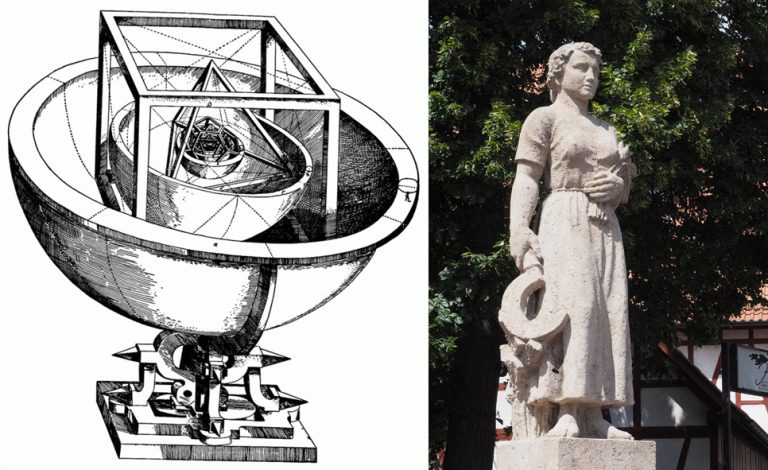
Kepler’s model of the solar system.
Statue of Katharina Kepler in Eltingen. Harke, CC BY-SA
Kepler was never to see the publication of Somnium in his lifetime. His mother, Katharina, was caught up in the witch hunting mania which swept through Europe in the 16th and 17th centuries. Known as a difficult woman, brought up by an aunt who had been burned as a witch, it seems that it was only a matter of time before Katharina would be accused of the same crime. To make matters worse, Kepler’s Somnium, in which the mother of the protagonist is described as a ‘wise woman’, who sells lucky charms to passing sailors, was taken to be autobiographical evidence that his mother was a witch, and was used against her in the trial. Kepler abandoned his work to fight a legal battle for his mother’s life which would last six years. Fourteen months of this time was spent by Katharina chained to the floor of a prison cell and threatened with torture in an effort to extract a confession of witchcraft. Kepler’s defence of his mother is said to have been a triumph of reason against superstition and she was eventually cleared of the charges. However, the trial and privations of prison had taken their toll on her, and she died only six months later.

The Decision to go to the Moon, John M. Logsdon, 1920.
President John F. Kennedy delivers his proposal to put a man on the Moon before a joint session of Congress, May 25, 1961. By NASA (Great Images in NASA Description)
The Decision to Go to the Moon: Project Apollo and the National Interest by John M. Logsdon (Item sold)
John Logsdon, founder of the Space Policy Institute at George Washington University and former member of the NASA advisory council, published this account of the decision making process which led to the first manned moon landing only a year after the success of Apollo 11. Reconstructing the series of events which saw the announcement in 1961 of John F. Kennedy’s decision to reach the moon “before this decade is out”, Logsdon casts the Apollo Project in a political, rather than a military light, citing the Soviet Space Program as the clear motivating factor in the immense and single-minded effort which put Neil Armstrong on the moon. President Kennedy, according to Logsdon, was not himself a particular enthusiast for space exploration, remarking to one of his advisors “if you had a scientific spectacular on this earth that would be more useful – say desalting the ocean – or something just as dramatic and convincing as space, then we would do that.” However, Kennedy did believe that American international security was inextricably linked to its unshakable position as the world’s leading technological force. He asked his advisors to come up with a space race that American could win and they responded with a feasible plan to put an American on the moon, stating in their report that “it is man, not merely machines, in space that captures the imagination of the world.”

Ionosphere, (Floyd D. Hall), 1968
Ionosphere. (HALL, Floyd D.)
This remarkable blue leather case, presented to Newell by chairman and chief executive of the now defunct Eastern Airlines, contains an eclectic and charming collection of material which illustrates the story of man’s efforts in communication, exploration and navigation. Ionosphere is, in Hall’s words, “an attempt to define the proper perspective of the airplane in the service of mankind”. The contents of the case comprises a short brochure including poetry and literary quotations which illustrate the message of Ionosphere, and four folders entitled respectively ‘Man Learns to Find His Way’, ‘Man Learns to Communicate’, ‘Man Learns to Multiply His Strength’ and ‘Man Learns to Fly’. These folders contain a beautifully presented collection of material including a working astrolabe, a recreation of a page from the Gutenberg bible, notes on the creation of the first steam engine and a hitherto unpublished photograph of the first flight of the Wright brothers in 1905.
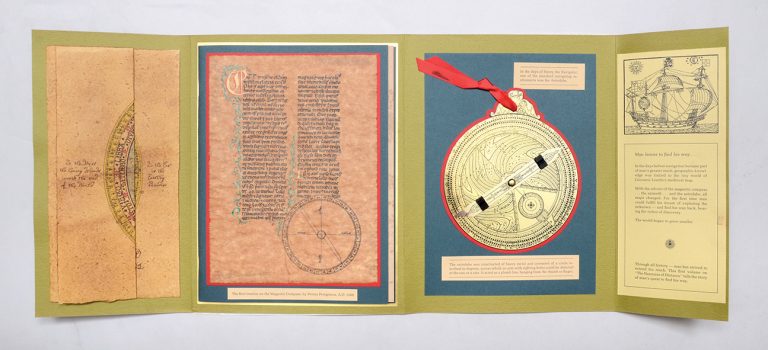
From ‘Man Learns to Find His Way’
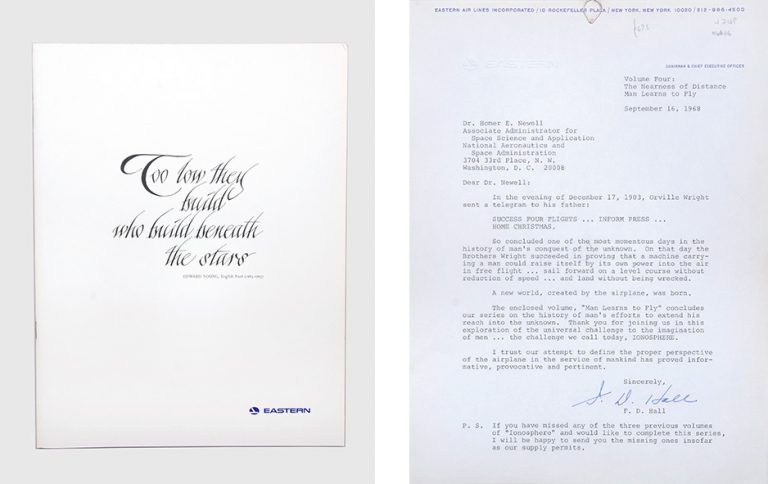
Brochure accompanying Ionosphere and the letter from Floyd Hall presenting the collection to Newell
Other items from the collection of Dr Newell include:
ROSEN, Milton W – The Viking Rocket Story, 1955 (Item sold)
(FOX, Sidney W., ed.) – The Origins of Prebiological Systems and of Their Molecular Matrices, 1965 (Item sold)
VAETH, J. Gordon – Weather Eyes in the Sky: America’s Meteorological Satellites, 1965 (Item sold)
NEWELL, Homer E. – Guide to Rockets, Missiles, and Satellites, 1958




